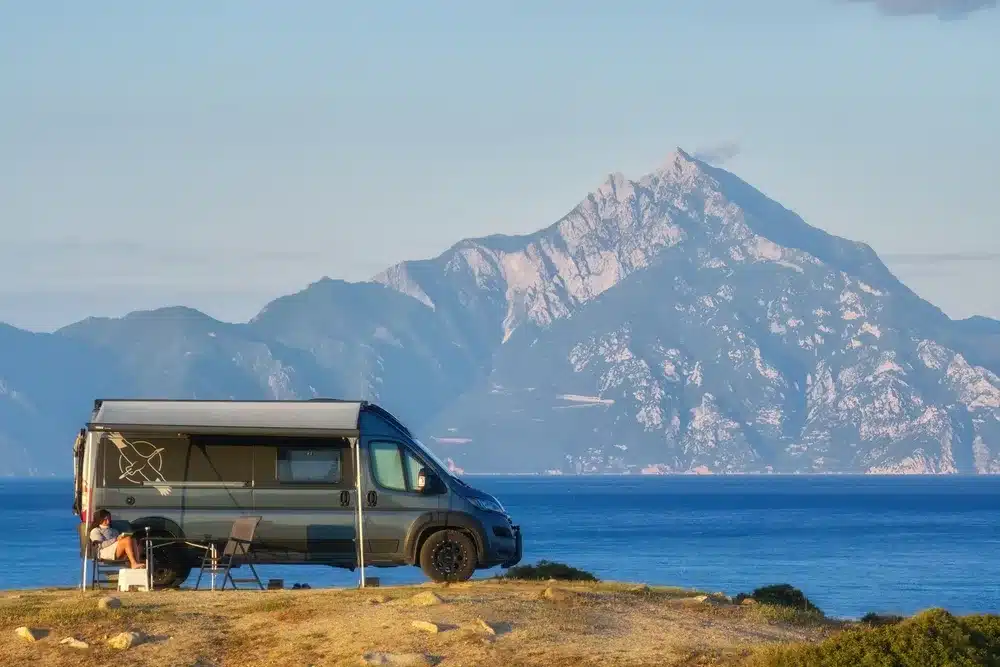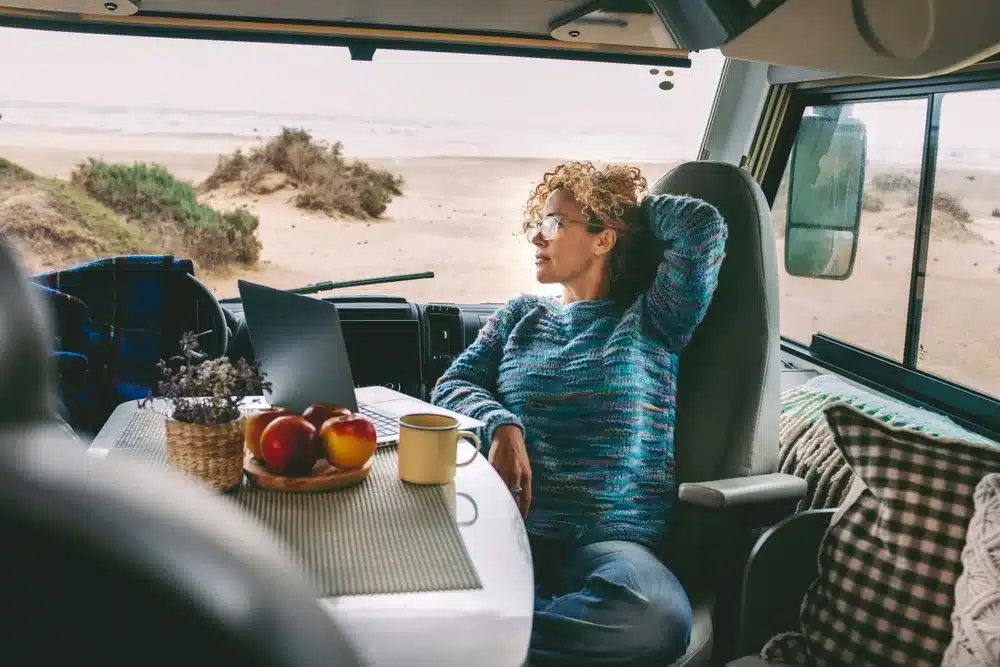Picture this. You wake up each day with a new view outside your window — mountains one morning, beach the next. Living in a camper full-time means living an unfettered life of freedom and discovery. But, for all the perks, this lifestyle has its own set of challenges: from budgeting to figuring out where to park safely and managing repairs on the go.
Interested in knowing how to make an RV a permanent home? We’ll give you an honest look at what it’s like to live on the move before trading your house keys for RV keys.
What Is Living in a Camper Full-Time Really Like

Living full-time in an RV offers an incredible sense of freedom, but there’s also a big learning curve and some unexpected adjustments.
For many, RV life means adapting to a smaller space and a simpler way of living. Ashlyn Socinski, a Knoxville-based travel wedding photographer at Willow + Rove, who spent six months traveling in a fifth wheel with her family, shares, “If you are traveling with children, or multiple people in general, it gets tight. You pretty much lose all of your personal space, especially if it’s raining and no one is going outside. Sometimes your neighbors suck. But there are always pros to these things.”
Another reality of RV life is that breakdowns and repairs are part of the package.
“All RVs are built pretty sloppily because they aren’t meant to be lived in, so things break often,” Socinski added.
Living in an RV requires a bit of a “handy” mindset — you’ll likely find yourself hammering nails or tightening screws now and then. RVers should be ready to handle these maintenance issues and even bring along a toolkit with spare parts. And one more thing, you need to be flexible, as conditions change on the road. From finding a place to park to dealing with the weather, you’ll need to stay adaptable. But overcoming the small frustrations of RV life is worth it for the chance to see different places and meet new people.
How to Choose an RV
Planning to live in an RV full-time starts with picking the right rig, and not just the size. You have to find a setup that matches your daily needs, your travel plans and, of course, your budget.
The first thing Socinski took into account when deciding on an RV model was accommodating her family, including two kids who each wanted their own space. “We found a fifth wheel (the Keystone Avalanche 390DS) with two bedrooms, a loft and two full bathrooms. It was perfect.” If you have specific needs, like office space or extra storage, look for an RV model with a layout to support those features.
When selecting an RV, ask yourself these questions on size and layout, and decide on tank capacity and the features that work for you:
- How much room do you need? A larger RV can be comfortable, but it’s also more difficult to maneuver and might limit where you can park.
- Think about the daily activities you’ll do in the RV. Do you need a closed-off workspace? Enough beds? A large kitchen area?
- Larger water tanks are helpful if you plan to camp without hookups. Smaller tanks are easier to manage if you’ll mostly be at sites with full hookups.
- Decide what amenities are important to you. For some, an in-RV washer and dryer are essential; others are fine using campground facilities.
The right RV makes life on the road easier and more comfortable. As Socinski pointed out, it’s about finding what suits your lifestyle best and makes life feel manageable, whether you’re settling in for a few days or moving often.
Planning and Budgeting for Living in a Motorhome

Before committing to the RV lifestyle full-time, you should have a solid plan and a budget in mind. When it comes to RV living, be ready for costs like campsite fees and propane for heating, as they can really add up fast!
As Socinski also advises, flexibility in your budget is key. “If you’re moving more often than every three months, don’t expect to save money by moving into an RV. Standard campgrounds are expensive.”
It’s true. Staying in an RV park with amenities can be pricier than some people expect, especially if you’re moving frequently. However, alternative options like camping on Bureau of Land Management (BLM) land can help lower costs, though they may lack basic services like water and electricity.
When creating your budget, keep these key expenses in mind:
- Campground fees: Private RV parks offer amenities but tend to cost more. Public lands are cheaper but have limits on stay lengths and fewer hookups.
- Fuel costs: Avoid unnecessary mileage, as traveling from one location to another can be costly, especially with a larger RV. “Having to find a truck map app to navigate roads was beneficial,” says Socinski. “We would have that map open along with Google Maps and determine the differences and plan ahead while driving.”
- Propane: Heating and hot water often rely on propane, which adds up, especially in colder months. Frequent refills are an extra cost in winter.
Pro Tip: RV Memberships like Thousand Trails can reduce campsite fees, although availability may vary by season and location.
For new RVers, Socinski suggests planning out travel routes, campground stays and even weather considerations months in advance. With a clear budget and a realistic understanding of expenses, you’ll find it much easier to manage the RV lifestyle without stress.
Prepare for the Road Like a PRO
Before heading out into the new full-time RV life, there are a few practical things to get squared away, like having a legal address, setting up a way to get your mail and double-checking your insurance.
First up is choosing a “domicile” — that’s your legal address, even if you’re always moving. This matters for things like taxes, voting and car registration. If you don’t already have an address you can use (like a family member’s), some states like Florida, Texas and South Dakota have services that specialize in RVers.
Next is mail forwarding. RVers often use mail services, like those offered by Escapees RV Club or iPostal1, that collect, scan and forward their mail wherever they’ll be staying next. This way, you can stay in the loop without worrying about missed mail.
Here’s a quick prep checklist before you go:
- Choose an address, whether through a family member or an RV-friendly service.
- Use a mail forwarding service to collect, scan and send your mail on the road.
- Make sure your RV insurance covers full-time use, roadside help and any extras you might need.
- Staying connected matters, so check out mobile hotspots or satellite options like Starlink if you need reliable internet.
Pro Tip: Make a checklist for moving days. Tasks like locking cabinets and securing appliances help prevent messes or damage when you’re moving from one spot to the next.
Where to Park and Sleep When Living in a Recreational Vehicle
One of the biggest parts of RV life is figuring out where you’ll stay each night.
As we mentioned earlier, private RV parks often have hookups for water and electricity, plus facilities like laundry or showers. These all come at a cost.
State and national parks cost less and bring you closer to nature, but you might have to limit water and electricity use, and you’ll need to move on after a set time.
The most budget-friendly option is “boondocking” on public lands like BLM areas. You get a free spot to park, often with beautiful, remote surroundings, but since these areas have no services, you’ll need to plan for water, power and waste.
Harvest Hosts has a really great app that Socinski swears by. “People will lend out their property at a business, farm, winery, brewery, etc. to let you park for a night or two when you are moving between locations. Some of them offer electricity and water hookups. They just ask that you buy something from their store or support them in some way,” she explained. Through the app, Socinki’s family booked a stay at a little farm sanctuary that had all white peacocks.
Here are a few quick tips for finding the right spot:
- Book early if you have your heart set on popular spots — campgrounds fill up fast in peak seasons. “Speaking of seasons, the winter sucks if you can’t find somewhere to go down south,” said Socinski. “I would try to book 6 months out, sometimes even 12 months if it’s a popular seasonal campground.”
- Stay flexible if you’re exploring high-demand areas. Less popular campgrounds nearby might have openings.
- Know your RV’s size limits since some campgrounds can’t handle larger rigs.
Expecting the Unexpected: Common Situations and Solutions

Living full-time in an RV brings all kinds of surprises, and sometimes things don’t go as planned.
For starters, repairs are part of the RV lifestyle. From cabinet doors coming loose to appliances giving out, having a toolkit and some basic repair skills will save you time and stress. It’s also smart to carry a few extra parts, like fuses or screws, to fix minor issues on the go.
Roads with size and height restrictions are another issue, and Socinski found using the truck map app helpful in avoiding low bridges and tight roads. “When in doubt, look for 18-wheeler trucks,” she advised. “If you see them on the same road, you should be good.”
Campground problems are common, too. Sometimes, a site looks fine online but doesn’t live up to expectations when you arrive. Socinski recalls arriving at a questionable campground once, “We stayed the night anyway, but by morning the sewer smell was awful, so we had to pack up and find a new place.” It’s for situations like these that you need an extra dose of flexibility and a backup plan.
Storing Your RV when Not in Use
Is it time to give life on the road a break? Keep your RV safe and road-ready for the next adventure with one of the many vehicle storage options out there. But, first things first: Storage facilities are not designed for living, so the RV is not going to be your backup home while it’s parked there. Storage.com can help you find the storage solution you’re looking for.
Here are your three main RV storage options:
- Outdoor storage is the most affordable way to go, but it leaves your RV exposed to the weather. A heavy-duty cover can help protect it from the elements, so it’s a decent choice if you’re looking to save and don’t mind a bit of exposure.
- Covered storage provides a bit of shade and shelter without breaking the bank, protecting your RV from direct sunlight and rain.
- Indoor storage is the “VIP suite” for your RV. It’s the most expensive, but your RV gets full protection from sun, rain, wind — everything. It also has an added layer of security, so it might be worth it if storing your RV for the long haul or through winter.
Note: Before parking, give the RV a good clean inside and out, seal up any cracks and handle any small repairs. Disconnect the battery, cover the tires and make sure the windows and doors are fully locked. That is a gross simplification, so here are all the essential steps to preparing your RV for winter (FAQ included).
Now You Know How To Make an RV a Permanent Home
So, that’s the real deal on living in a motorhome! From the new view each morning to the occasional wrench you’ll have to throw in (literally), full-time RVing is an adventure in every way. When you’re ready to trade in a fixed address for one that moves along with you, you’ll find a lifestyle that breathes flexibility, freedom and a whole load of adventure.
Ready to take the plunge? Start planning, pack your essentials and get ready for life on the road — RV style! And when it’s time to take a break, check out the indoor, outdoor and covered spots Storage.com has to offer for RVs of all types and sizes.
_ _ _
With so many options and a detailed rundown on each facility, Storage.com takes the headache out of finding that perfect storage unit. From climate control options to 24-hour accessibility, our inventory has everything you might need from a storage unit. Just search, compare and reserve your unit with ease on Storage.com.




